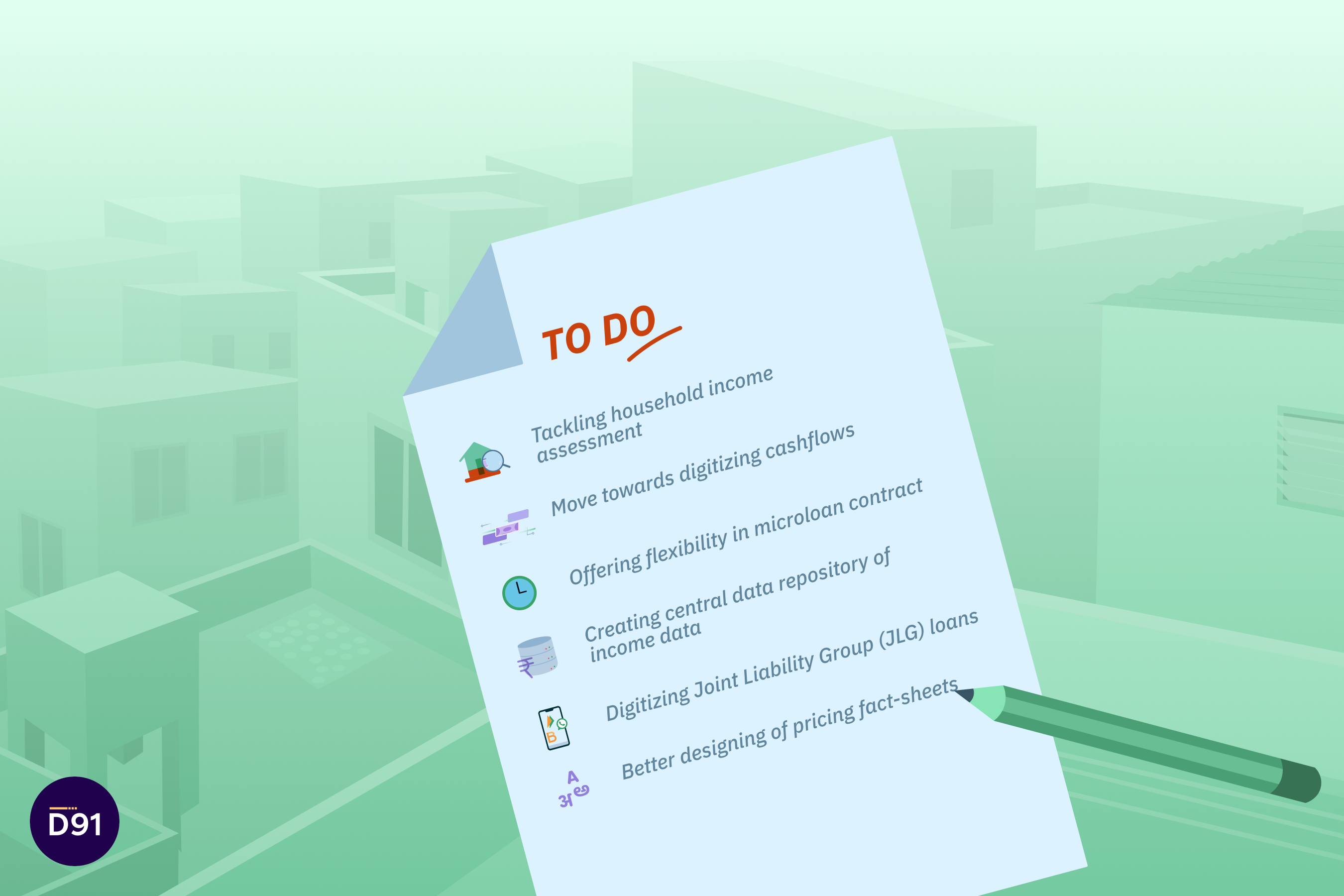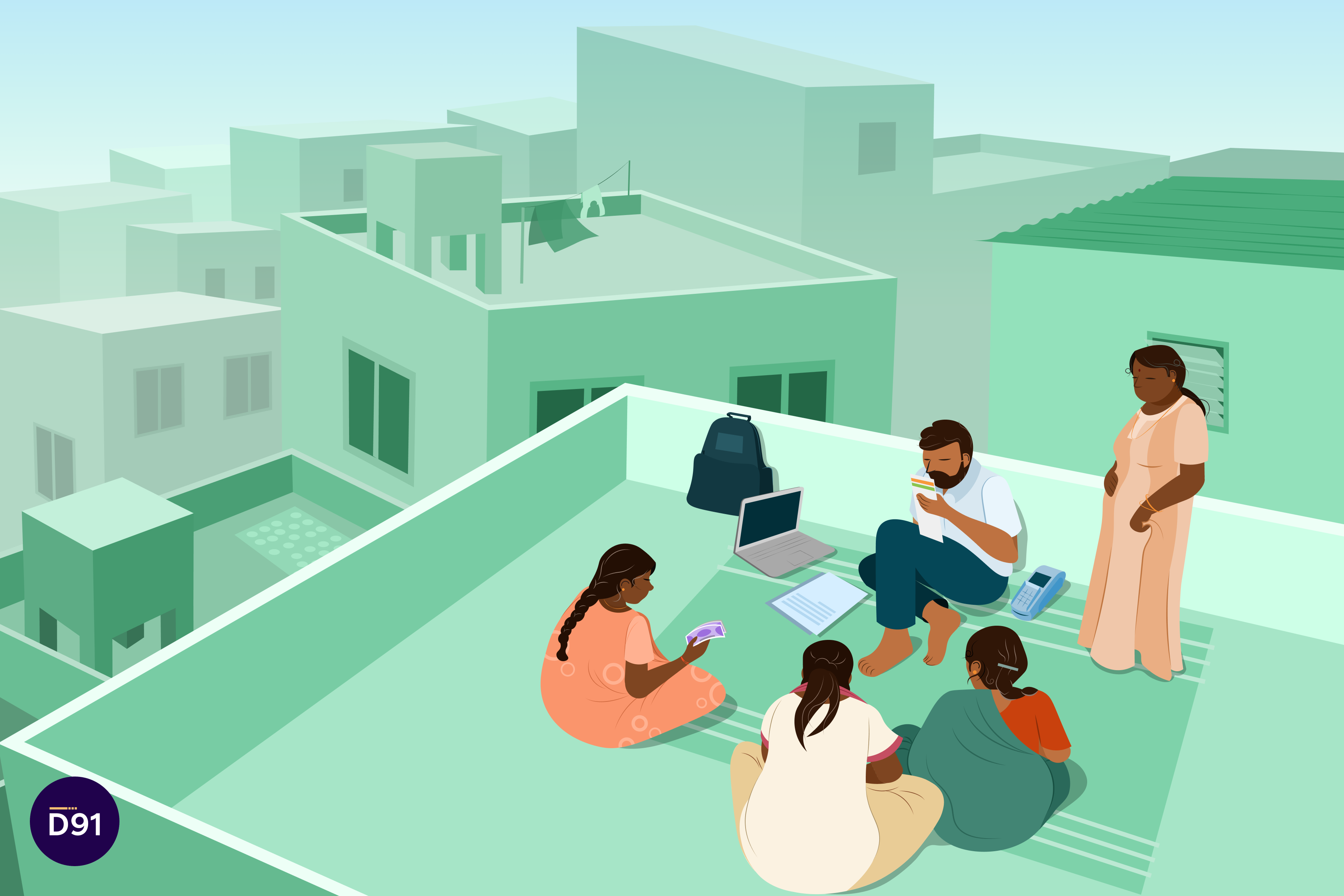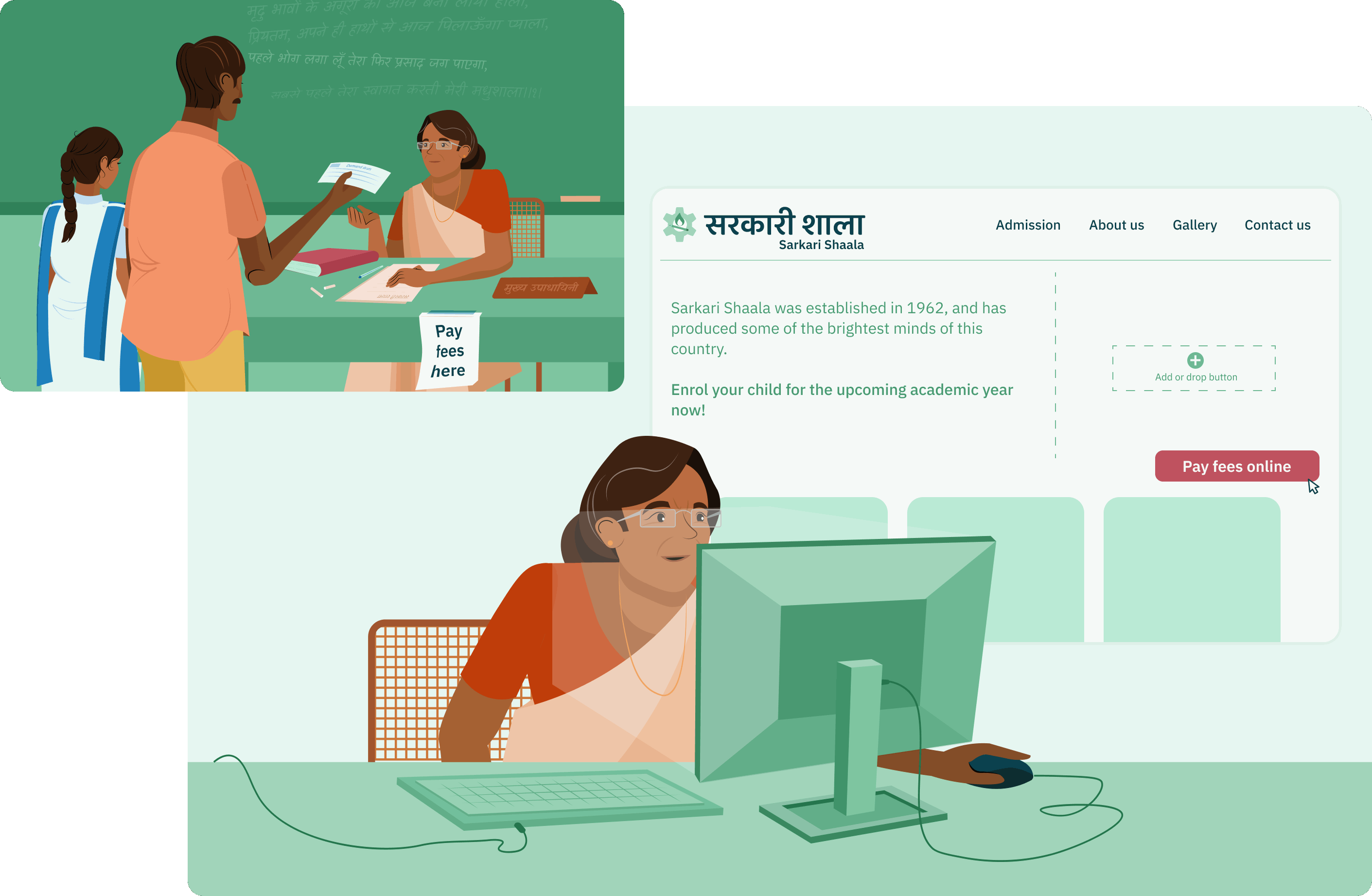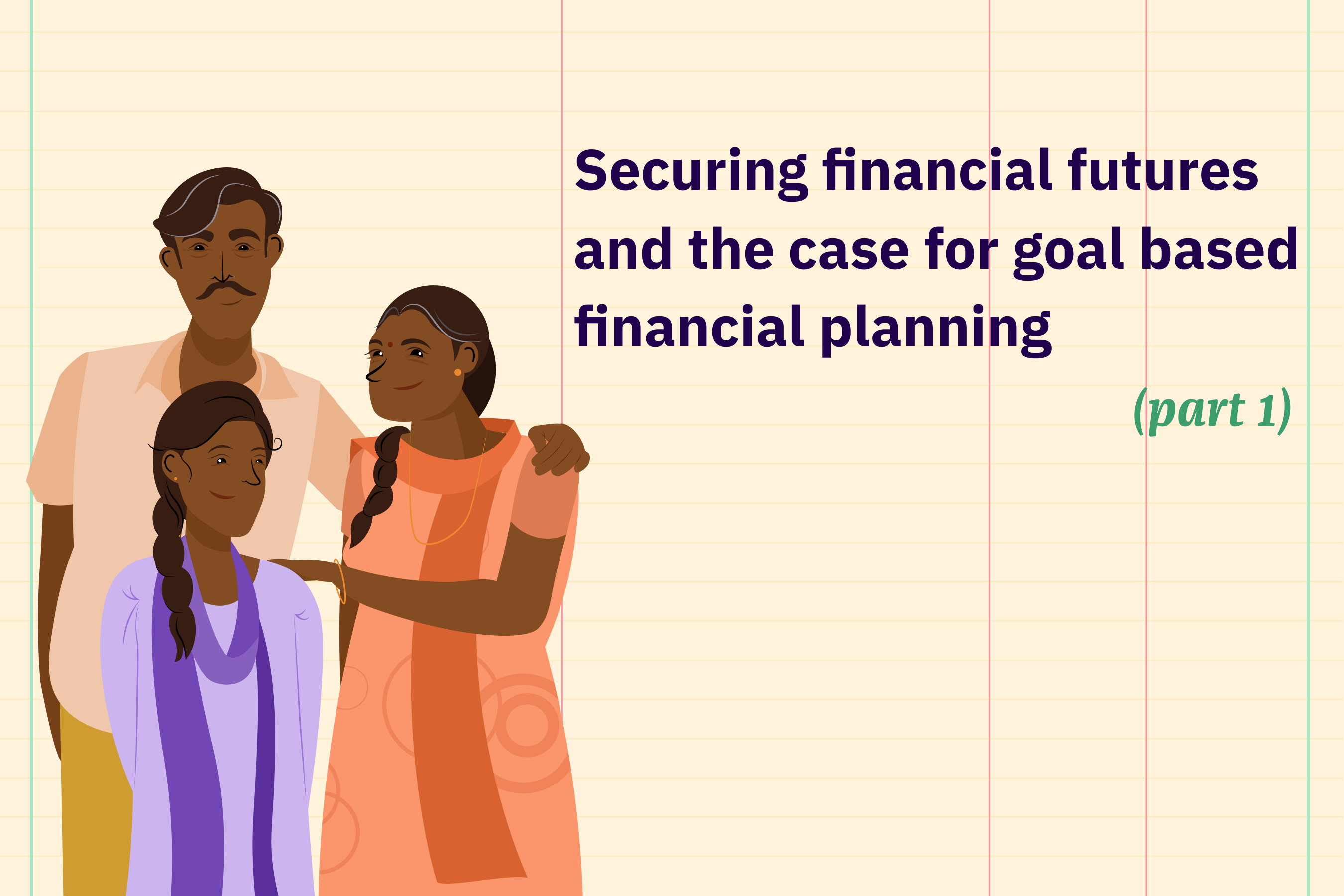The future of microloans—Part II
7 Aug 2021 — D91 LABS — TALES OF BHARAT

In the previous blog, we discussed some of the regulations proposed by RBI for microfinance lenders. In this blog, we explore how tech can aid the implementation of RBI’s proposal, pave the way for cashless collections, reduce operational costs, offer customized credit, and inform the borrower about their loan contracts.

1. Tackling household income assessment
RBI proposed that the loans will be based on the assessment of the borrowers’ household income. The payment of interest and repayment of principal for all outstanding loans of the household at any point in time shall be capped at 50 percent of the household income.
At a principle level, this recommendation is prudent and intends on protecting the customer but needs some clarification. For instance, household income as a unit of measurement for underwriting borrowers leaves out any expenses that the household makes towards savings, consumption expenditure, or expenses related to shocks. Instead of household income, the relevant measure should have been the borrower’s debt-servicing capacity (DSC).
The DSC is the proportion of household income minus households expenditure to the repayment obligation of the borrower. A detailed discussion on this can be found in research conducted by Dvara Research (2021)1. The concern with self-reported household cashflow values is that they can be inaccurate and difficult to cross-validate. This problem is significant for households that receive wages and transact in cash.

2. Corollary - A move towards digitizing cashflows
If the household income assessment proposal is implemented, it could lead to the digitization of cashflows even for the low-income household. Under the current recommendations, providers will have the liberty to offer differential rates of interest for borrowers willing to repay digitally versus by cash. This may push households to use their bank accounts and make their payments through digital applications, thus creating a digital footprint.
The pandemic has already accelerated digital collections of repayments. It has also reduced the turn-around time for the disbursement of microloans, thereby reducing operational costs due to paperless documentation and digital processes. These changes in processes could incentivize households to create a digital footprint by using bank accounts and payment gateways to receive wages, loan disbursements2, loan repayments as well as carry out other regular purchases.
Fintech pathways such as UPI, e-KYC, e-Nach, AEPS, WhatsApp banking, and other digital applications have the potential to pave the way for digitizing the microcredit sector.
 3. Offering flexibility in microloan contracts
3. Offering flexibility in microloan contracts
RBI also proposes for banks and NBFCs to have a Board approved policy to provide the flexibility of repayment schedule to microfinance borrowers as per their requirement.
Digitizing the microcredit sector can encourage flexibility in loan contracts. Till now, most group loans and individual loans had a standardized repayment schedule. Rigid product design simplifies the disbursement and collection processes for the provider but it may not be suitable for households with volatile cash flows. Such unbending product design can lead to overindebtedness as households regularly borrow expensive credit to repay microloans.
RBI’s proposal can encourage the microcredit industry to innovate and customize products that align with the cashflows of occupations with seasonal business cycles. A basic but important use-case could be designing a customized loan for agriculture-based households and align the disbursement and repayment timeline with the sowing and harvesting season. This use case applies to other seasonal occupations and life-cycle events.
The sector will now have the option to introduce flexibility in the form of the repayment schedule but can also explore flexibility in the form of EMI amount, one-time repayment holiday, and prepayment. Digitizing collection can open the doors for flexible terms of credit as well as cut down the cost of collection and other operational costs, reduce cash-storage expenses, diminish the chances of fraud and reduce the workload for the field staff.
 4. Need for a central data repository of income data
4. Need for a central data repository of income data
The household income thresholds set by RBI for the urban and rural customers remain ₹1,25,000 and ₹2,00,000 for rural and urban/semi-urban households respectively.
The assessment of household income can be made easier for microfinance lenders by building an income data repository that can serve two purposes.
Firstly, it will serve as a benchmark for cross-validating the self-reported household income values.
Secondly, the income threshold for rural and urban households can be revised periodically. According to the current recommendations, uncollateralized micro-loans can be disbursed to households with an annual income of ₹1,25,000 and ₹2,00,000 for rural and urban/semi-urban areas. This value needs to be updated regularly and adjusted for inflation.
The data collection process for such a repository could be based on regular (ideally quarterly) surveys and could publish disaggregated district-wise, occupation-wise, and gender-wise income data.

5. Digitizing Joint Liability Group (JLG) loans
A significant share of the SFB and NBFC-MFI’s lending portfolio comprises JLG loans. A Joint Liability Group (JLG) is an informal group comprising of 4-10 individuals coming together to avail bank loans on an individual basis or through group mechanisms against mutual guarantee. Generally, the members of a JLG would engage in a similar type of economic activity. In certain groups, members may prefer to undertake different types of economic activities as well. The members would offer a joint undertaking to the bank to enable them to avail loans3.
In a typical collection process either an MFI agent visits the borrower to collect the repayment in cash or the borrower walks to a physical branch to make the payments. This process can be digitized by allowing repayments through Bharat Bill Payment System (BBPS), UPI apps such as Google Pay and PhonePe, or through cash collection facilitated by AePS at the local Kirana store. A neat illustration of the workflow (and challenges) can be found in one of our previous blogs here.
The pandemic has pushed providers to rethink their collection processes. RBI’s push to deregulate interest rates for microloans offered by NBFC-MFI could lead to product innovation and accelerate the adoption of digital channels for repayment of loans. However, instead of pushing borrowers to adopt digital repayments, it would be prudent to offer them an assisted/phygital mode of repayment that could involve some human interaction level. A recent study by Microsave and NPCI illustrates the design and advantages of an assisted mode of digital repayments.

6. Better designing of pricing fact-sheet for the convenience of customers
The consultation paper recommends that customers should be given a standardized and simplified one-page disclosure format containing information only on the pricing of microfinance loans.
This could be useful for the end borrower as it will assist them in making an informed choice about their loan product. In our opinion, this fact sheet should be available in vernacular languages and also have a scannable QR code that directs users to a video that explains each line item in the sheet in greater detail and gives them clarity about the loan contract.
Overall, the recommendations are a welcome move from RBI and have the potential to encourage providers to innovate and reach newer regions and customer segments. If implemented correctly, it could reduce overindebtedness as well as accelerate cashless repayments among microfinance customers.
Special thanks to Atulaa Krishnamurthy and Basil Roy for their insightful views.
All illustrations were created by Prajna Nayak.
1 Dvara Research (2021) - [https://www.dvara.com/research/wp-content/uploads/2021/01/Detecting-Over-Indebtedness-while-Monitoring-Credit-Markets-in-India.pdf](https://www.dvara.com/research/wp-content/uploads/2021/01/Detecting-Over-Indebtedness-while-Monitoring-Credit-Markets-in-India.pdf)
2 90% of loan disbursement is already made digitally
3 RBI circular - https://www.rbi.org.in/Scripts/NotificationUser.aspx?Id=9336&Mode=0




